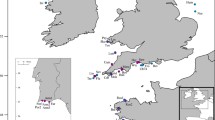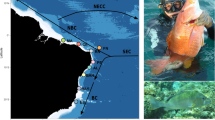Abstract
Understanding patterns of connectivity among marine fish populations with demersal adults and pelagic larvae is critical for effective conservation of west coast rockfishes. The brown rockfish (Sebastes auriculatus) occurs in nearshore habitat and is common from northern Baja California, Mexico to northern California, rare off the outer coast of Oregon and Washington and again common in the inland waters of Puget Sound, Washington. Here we examine patterns of microsatellite DNA diversity from throughout the species’ range as an indirect measure of long-term trends in larval dispersal. Genetic divergence was large and highly significant over all populations (F ST=0.056, P<0.0001), and was significantly correlated with geographic distance when considering coastal populations. The best estimates of mean coastal dispersal distance were on the order of 10 km or less per generation. Diversity was relatively low in the Puget Sound, suggesting that Puget Sound rockfish populations experienced a post-glacial founder effect followed by genetic isolation and low effective population size. Puget Sound individuals appeared to have recent mixed ancestry as a result of introgression with S. maliger and S. caurinus. Genetic isolation of Puget Sound fish provides a basis for consideration as a Distinct Population Segment (DPS) under the provisions of the Endangered Species Act. We recommend that coastal brown rockfish fisheries be managed at regional rather than coast-wide scales, and that design of marine reserve networks considers the surprisingly low realized dispersal distance of some species with high dispersal potential.
Similar content being viewed by others
References
Airame S, Dugan JE, Lafferty KD, Leslie H, McArdle DA, Warner RR (2003). Applying ecological criteria to marine reserve design: a case study from California Channel Islands. Ecol. Appl. 13 (Suppl.): S170–S184
Allison GW, Gaines SD, Lubchenco J, Possingham HP (2003). Ensuring persistance of marine reserves: Catastrophes require adopting an insurance factor. Ecol. Appl. 13(Suppl.): S8–S24
Botsford LW, Hastings A, Gaines SD (2001). Dependence of sustainability on the configuration of marine reserves and larval dispersal distance. Ecol. Lett. 4: 144–150
Botsford LW, Micheli F, Hastings A (2003). Principles for the design of marine reserves. Ecol. Appl. 13(Suppl.): S25–S31
Buonaccorsi VP, Kimbrell CA, Lynn EA, Vetter RD (2002). Population structure of copper rockfish (Sebastes caurinus) reflects postglacial colonization and contemporary patterns of larval dispersal. Can. J. Fish. Aquat. Sci. 59: 1374–1384
Buonaccorsi VP, Westerman M, Stannard J, Kimbrell CA, Lynn EA, Vetter RD (2004). Molecular genetic structure suggests limited larval dispersal in grass rockfish, Sebastes rastrelliger. Mar. Biol. 145: 779–788
California Department of Fish and Game (2000) Brown rockfish Sebastes auriculatus1993–1999 commercial catch by ports and blocks. In: Marine fishery profiles, Vol 1: Nearshore. CDFG Marine Region GIS Lab, Sacramento.
Ebbesmeyer CC, Cannon GA, Barnes CA (1984). Synthesis of current measurements in Puget Sound, Washington - Volume 3: Circulation in Puget Sound: An interpretation based on historical records of currents. NOAA Tech. Mem. NOS-OMS-5: 1–73
Eschmeyer WN, Herald ES, Hammann H (1983). A field guide to Pacific fishes of North America, from the Gulf of Alaska to Baja California. Houghton Mifflin, Boston, MA
Garza JC, Williamson EG (2001). Detection of reduction in population size using data from microsatellite loci. Mol. Ecol. 10: 305–318
Gerber LR, Botsford LW, Hastings A, Possingham HP, Gaines SD, Palumbi SR, Andelman S (2003). Population models for marine reserve design: A retrospective and prospective synthesis. Ecol. Appl. 13(Suppl. 1): S47–S65
Goudet J (2001) FSTAT, a program to estimate and test gene diversities and fixation indices (version 2.9.3). Available from http://www.unil.ch/izea/softwares/fstat.html
Hartmann AR (1987). Movement of scorpionfishes (Scorpaenidae: Sebastes and Scorpaena) in the Southern California Bight. Fish. Bull. Calif. Dep. Fish Game 73: 68–79
Jackson GA, Winant CD (1983). Effect of a kelp forest on coastal currents. Cont. Shelf Res. 2: 75–80
Largier JL (2003). Considerations in estimating larval dispersal distances from oceanographic data. Ecol. Appl. 13(Suppl.): S71–S89
Lea RN, McAllister RD, VenTresca DA (1999). Biological aspects of nearshore rockfishes of the genus Sebastes from Central California. Fish. Bull. Calif. Dep. Fish Game 177: 1–109
Lenarz WH, Vantresca DA, Graham WM, Schwing FB, Chavez F (1995). Explorations of el Nino events and associated biological population dynamics off central California. CCOFI Rep. 36: 106–119
Levin DA (2002). Hybridization and extinction. Am. Sci. 90: 254–261
Love MS, Caselle JE, Herbinson K (1998). Declines in nearshore rockfish recruitment and populations in the southern California Bight as measured by impingement rates in coastal electrical power generating stations. Fish. Bull. 96: 492–501
Love M, Yoklavich M, Thorsteinson L (2002). The rockfishes of the northeast Pacific. University of California Press, Berkeley & Los Angeles, California
Lubchenco J, Palumbi SR, Gaines SD, Andelman S (2003). Plugging a hole in the ocean: the emerging science of marine reserves. Ecol. Appl. 13(Suppl.): S3–S7
Mathews KR (1990). An experimental study of the habitat preferences and movement pattern of copper, quillback and brown rockfishes (Sebastes spp.). Environ. Biol. Fishes 29: 161–178
Miller DJ, Lea RN (1972). Guide to the coastal marine fishes of California. Fish. Bull. Calif. Dep. Fish Game 157: 1–249
Moser G (1996). The early stages of fishes in the California current region. CCOFI Atlas 33: 1–1505
Musick JA, Harbin MM, Berkeley SA, Burgess GH, Eklund AM, Findley L, Gilmore RG, Golden JT, Ha DS, Huntsman GR, McGovern JC, Parker SJ, Poss SG, Sala E, Schmidt TW, Sedberry GR, Weeks H, Wright SG (2000). Marine, estuarine and diadromous fish stocks at risk of extinction in North America (Exclusive of Pacific Salmonids). Fisheries 25: 6–30
Nei M (1987). Molecular evolutionary genetics. Columbia University Press, New York
Palumbi SR (1992) Marine speciation on a small planet. Trends Ecol. Evol. 7: 114–118
Palumbi (1994) Genetic divergence, reproductive isolation, and marine speciation. Annu. Rev. Ecol. Syst. 25: 547–572
Palumbi SR (2001). The ecology of marine protected areas. In: Bertness MD, Gaines SD, Hay M (eds) Marine Community Ecology. Sinauer Assocates, Inc., Sunderland, MA, pp. 509–530
Pritchard JK, Stephens M, Donnelly PJ (2000) Inference of population structure using multilocus genotype data. Genetics 155: 945–959
Raymond M, Rousset F (1995). GENEPOP (version 1.2): Population genetics software for exact tests and ecumenicism. J. Hered. 86: 248–249
Rocha-Olivares A, Vetter RD (1999). Effects of oceanographic circulation on the gene flow, genetic structure, and phylogeography of the rosethorn rockfish (Sebastes helvomaculatus). Can. J. Fish. Aquat. Sci. 56: 803–813
Roques S, Sevigny J, Bernatchez L (2001). Evidence for broadscale introgressive hybridization between two redfish (genus Sebastes) in the North-west Atlantic: a rare marine example. Mol. Ecol. 10: 149–165
Roques S, Sevigny J, Bernatchez L (2002). Genetic structure of deep-water redfish, Sebastes mentella, populations across the North Atlantic. Mar. Biol. 140: 297–307
Rousset F (1997). Genetic differentiation and estimation of gene flow from F-Statistics under isolation by distance. Genetics 145: 1219–1228
Schneider S, Roessli D, Excoffier L (2000) Arlequin ver 2.000. A software for population genetics data analysis. U. Geneva, Geneva
Seeb L (1998) Gene flow and introgression among three species of rockfishes, Sebastes auriculatus, S. caurinus, and S. maliger. J. Hered. 89: 393–403
Seehausen O, van Aphen JJM, Witte F (1997). Cichlid fish diversity threatened by eutrophication that curbs sexual selection. Science 277: 1808–1811
Sokal RR, Rohlf, FJ (1995). Biometry. 3rd edn. W. H. Freeman & Co., New York
Stout HA, McCain BB, Vetter RD, Builder TL, Lenarz WH, Johnson LL, Methot RD (2001) Status review of copper rockfish (Sebastes caurinus), quillback rockfish (S. maliger), and brown rockfish (S. auriculatus) in Puget Sound, Washington. NOAA Tech. Mem. NMFS-NWFSC-46: 1–158
Taylor MS, Hellberg ME (2003). Genetic evidence for local retention of pelagic larvae in a Caribbean reef fish. Science. 299: 107–109
Thorson RM (1980). Ice-sheet glaciation of the Puget lowland, Washington, during the Vashon Stade (Late Pleistocene). Quatern. Res. 13: 303–321
Vetter RD, Lynn EA (1997). Bathymetric demography, enzyme activity patterns, and bioenergetics of deep-living scorpaenid fishes (genera Sebastes and Sebastolobus): paradigms revisited. Mar. Ecol. Prog. Ser. 155: 173–188
Waples RS (1998). Separating the wheat from the chaff: Patterns of genetic differentiation in high gene flow species. J. Hered. 89: 438–450
Ward RD, Woodwark M, Skibinski DOF (1994). A comparison of genetic diversity levels in marine, freshwater, and anadromous fish. J. Fish Biol. 44: 213–232
Warner RR, Cowen RK (2002). Local retention of production in marine populations: evidence, mechanisms, and consequences. Bull. Mar. Sci. 70 (Suppl.): 245–249
Weir BS, Cockerham CC (1984). Estimating F-statistics for the analysis of population structure. Evolution 38: 1358–1370
Withler RE, Beacham TD, Schulze AD, Richards LJ, Miller KM (2001). Co-existing populations of Pacific ocean perch, Sebastes alutus, in Queen Charlotte Sound, British Columbia. Mar. Biol. 139: 1–12
Zeidberg LD, Hamner WM (2002). Distribution of squid paralarvae, Loligo opalescens (Cephalopoda: Myopsida), in the southern California Bight in the three years following the 1997–1998 El Niño. Mar. Biol. 141: 111–122
Acknowledgements
We would like to acknowledge all those who assisted in sample collection: J. West (WDFW), R. Pacunski/W. Palsson (WDFW), E. Roberts (CDFG), Bodega Bay port samplers, Bodega Marine Lab, J. Hyde (SIO), S. Grossberg, D. Bodenmiller/D. LaPoint (ODFW), C. Sowell/N. Wilsman (ODFW), P. Kalvass/P. Wright (CDFG), R. Leos/J. Haws (CDFG), D. Allen, R. Nakamura/T. Olive/A. Floyd (Cal Poly), D. Pondella (Vantuna Research Group), A. Vejar (CDFG), N. Kellar (SIO), J. Stannard, M. Shane (Hubbs Seaworld), A. Rocha (CICESE), R/V RG Sproul, R/V David Starr Jordan, C. Taylor (SIO), L. Seeb, and D. Pearson. Funding for this project was provided by (1) NOAA Office of Protected Resources CP-01-SWC-2 Defining Distinct Population Segments (DPS’s) for Copper and Brown Rockfish. to RDV, (2) Marine Life Management Act-Population Genetics of the Nearshore Groundfish, a contract between Cal. Dept. Fish and Game and Scripps Institute of Oceanography to RDV and J. Hunter, (3) California Sea Grant R/F 175 to RDV, and (4) California Sea Grant Marine Ecological Reserves Research Program project 4-M-N to RDV and G. Moser.
Author information
Authors and Affiliations
Corresponding author
Rights and permissions
About this article
Cite this article
Buonaccorsi, V.P., Kimbrell, C.A., Lynn, E.A. et al. Limited realized dispersal and introgressive hybridization influence genetic structure and conservation strategies for brown rockfish, Sebastes auriculatus . Conserv Genet 6, 697–713 (2005). https://doi.org/10.1007/s10592-005-9029-1
Received:
Accepted:
Published:
Issue Date:
DOI: https://doi.org/10.1007/s10592-005-9029-1




